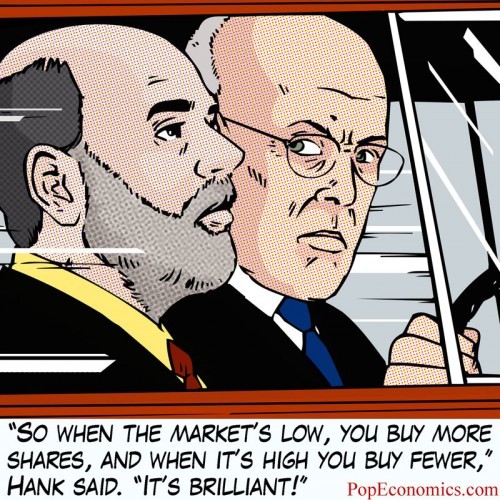Dollar cost averaging smooths out volatility Business
Post on: 9 Май, 2015 No Comment

Wouldn’t it be nice if you could smooth out all the rough spots in your personal investments?
Many investors have wondered just that during this frenetic market year that is constantly being buffeted by world events. Too often, they boldly invest when stock prices are high, then fearfully halt their investing or sell their holdings altogether when prices head downward.
Here’s a better plan: Dollar cost averaging, which involves investing the same amount of money on a regular basis. Relentless investing of a set amount removes the faulty market-timing decisions that are so often the downfall of average folks.
With dollar cost averaging, the investor benefits from buying stocks at bargain prices when the market is down. Conversely, when stocks are up, that same investor is prevented from getting too excited and overspending on stocks that cost too much.
There are plenty of vehicles that make dollar cost averaging easy to accomplish. If you participate in an employer-sponsored retirement plan that withholds a fixed amount of your paycheck, you may already be doing this type of systematic investing. Stick with the same percentage for your account, rather than varying it based on market conditions at any given time.
If someone is systematically investing with dollar cost averaging through either a 401(k) or regular investment account, there is an unlimited time horizon because it can go on and on, said Mark Brown, certified financial planner with Brown & Tedstrom Inc. in Denver. And, in the case of an investor receiving a lump sum of money, we invest half of it right away and then do dollar cost averaging with the other half.
Besides retirement accounts, a number of mutual funds have automatic investment plans that allow you to put in a relatively modest fixed amount each month. The same goes for dividend reinvestment plans at many companies that permit you to buy their stock directly, as long as you agree to a fixed amount each month. To be cost-effective, it is important to find a plan that doesn’t have sales charges or brokerage commissions every time you invest.
Dollar cost averaging forces you to be a buyer when your head says you should be but your heart can’t do it, said Charles Carlson, editor of DRIP Investor (www.dripinvestor.com) in Hammond, Ind. In 2008 and 2009, the only buying that many investors did was forced buying through dollar cost averaging strategies, and they are glad they did.
While Carlson’s newsletter is a longstanding proponent of the dividend reinvestment plans offered by high-quality, dividend-paying companies, he also sees advantages in diversified mutual funds as well.
One fund Carlson likes is Vanguard Total Stock Market Index Fund (VTSMX), which has a three-year annualized return of 8 percent that ranks in the top one-fourth of large growth and income funds. It replicates about 95 percent of the MSCI U.S. Broad Market Index, which includes virtually all domestically traded stocks. The portfolio has more than 3,300 stocks.
That fund’s lead manager is Gerard O’Reilly of Vanguard’s indexing team. This no-load (no sales charge) fund requires a $3,000 minimum initial investment and subsequent purchases can be made for $100. It has a low annual expense ratio of 0.18 percent.
Good mutual funds for dollar cost averaging are target funds (that adjust the asset mix as the target date approaches), balanced funds (that include stocks and bonds) and funds of high-dividend stocks that allow you to reinvest those dividends, said Dan Culloton, mutual fund analyst with Morningstar Inc. You will wind up with a better result than if you tried to time the market.
To point out the advantage to an investor who keeps at it on an ongoing basis, Culloton notes the following:
— An investor who invested $10,000 in the Standard & Poor’s 500 at the stock market peak of Oct. 9, 2007, and held it until August of 2011, would have wound up with a 4 percent annualized loss. The initial $10,000 would have fallen to $8,500.
— If the investor had invested $10,000 on Oct. 9, 2007, and followed it up by dollar cost averaging $1,000 a month until August of 2011, a 3.3 percent gain and $61,410 in the investor’s account would have been the result.
T. Rowe Price Equity Income Fund (PRFDX), with a three-year annualized return of 6 percent that ranks above the mid-point of large value funds, is one of Culloton’s favorites. The fund looks for dividend-paying companies trading inexpensively based on their historic prices but that are offering considerable upside. It has a portfolio of more than 100 stocks.
Portfolio manager Brian Rogers, who is also T. Rowe Price’s chief investment officer and chairman, has run this fund since its 1985 inception. According to filings, he has more than $1 million of his own money invested, thereby aligning his own goals with those of shareholders.
This no-load fund requires a $2,500 minimum initial investment, permits additional contributions of $100 and has a modest annual expense ratio of 0.69 percent.
When someone is just beginning to dollar cost average with a fund, I always anchor it in domestic and international blue-chip stocks, concluded Brown. You’re really trying to take advantage of the market and not an individual security.














